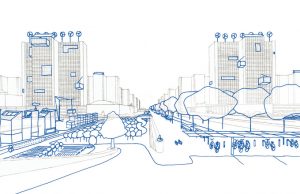Urban development should be guided by a sustainable urban planning and management vision that promotes interconnected green space, a multi-modal transportation system, and mixed-use development. Diverse public and private partnerships should be used to create sustainable and livable communities that protect historic, cultural, and environmental resources. In addition, policymakers, regulators and developers should support sustainable site planning and construction techniques that reduce pollution and create a balance between built and natural systems.
New sustainable urban developments or re-developments should provide a variety of commercial, institutional, educational uses as well as housing styles, sizes and prices. The provision of sidewalks, trails, and private streets, connected to transit stops and an interconnected street network within these mixed-use developments provides mobility options and helps reduce pollution by reducing vehicle trips. Walking, bicycling, and other mobility options should be encouraged throughout the urban mixed-use core and mixed-use neighborhoods with easily accessed and well-defined centers and edges.
Sustainable land management is the heart of Urban Planning, refers to practices and technologies that aim to integrate the management of land, water, biodiversity, and other environmental resources to meet human needs while ensuring the long-term sustainability of ecosystem services and livelihoods.
Sustainable Urban Planning is a growing design reform movement that combines the creation and enhancement of walkable and diverse places with the need to build high-performance infrastructure and buildings.
The following tactics can be used to move a city into a more sustainable path:
- Increasing sustainability through density.
- Integrating transportation and land use in an auto-dependent era.
- Creating sustainable neighborhoods with walk-to-work neighborhood centers of locally-owned businesses, car-sharing on every block, walkable neighborhoods and universal accessibility.
Integrating Land Use & Transportation Decision Making:
Transportation and land use planning are so intertwined by their nature that it is surprising they are commonly housed in different government departments with little conversation about their efforts.
The development of a multimodal approach to land use and transportation planning strengthens the transportation system by providing redundancy and reducing demand on any single mode and by providing higher density development opportunities around intersecting modes. Increased use of alternative transportation will also benefit the environment by reducing air pollution and conserving open space.
Strategies and Approaches:
- Transportation planning should be an inclusive and holistic process involving all communities and groups impacted by transportation infrastructure.
- Partnerships with non-traditional stakeholders can provide a new perspective and therefore strengthen planning.
- Fusing land use and transportation planning needs the support of strong leadership.
- Private developments can be key components of public projects.
- The creation of new planning tools should aim to increase public involvement in the development of transportation and land use policies.
It has been estimated that by 2050, nearly half of the Indian population will be living in urban areas – that is half of 1.70 billion people (the estimated population by 2050). In 2012, the government had even addressed the need to modernise these cities before they ‘implode’ under the pressure.
Recognising these challenges, the state has made efforts in speeding up the urbanisation process in the country. Initiatives like Jawaharlal Nehru National Urban Renewal Mission (JNNURM), and more recently Smart Cities Mission and AMRUT (Atal Mission for Rejuvenation and Urban Transformation), were launched to improve quality of life in cities, and developing more cities with modern facilities.
